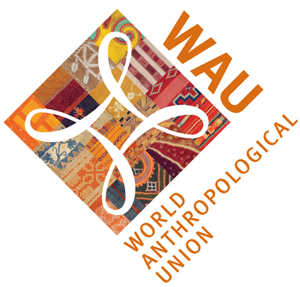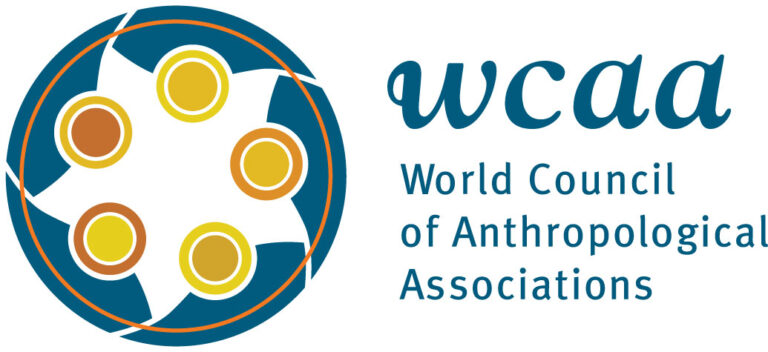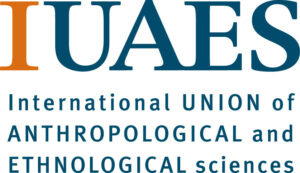
Frankland, Stan. 2016. “The Pygmy Mimic.” Africa 86(3): 552–570.
The Latin American literature on Conditional Cash Transfer (CCT) welfare programs has typically involved the quantitative evaluation of social and economic impact, with fewer studies addressing the qualitative and gendered impacts of CCTs. Drawing from ethnographic fieldwork in poor squatter settlement communities in Uruguay, this article explores the everyday social realities of poor single mothers who have been disconnected from their kinship networks and must rely on CCT payments for survival. I locate these women’s experiences within the third-way neoliberal discourses of ‘empowerment’, ‘participation’ and ‘self-help’ espoused by the state, and the various structural conditions, including crime, violence and unequal gender relations, that impact negatively on women’s abilities to comply with their social and civic duties. I argue that rather than producing responsible and empowered subjects, Uruguay’s recent CCT welfare program has paradoxically limited some women’s participation in civic and public life and reproduced their dependent relations with men.
La mimique pygmée est un trope colonial extrêmement persistant qui continue d’informer les interprétations anthropologiques contemporaines des populations pygmées d’Afrique. On considère aujourd’hui le mimétisme comme une composante essentielle de la reproduction sociale d’une façon distincte d’être pygmée. Dans cet article, l’auteur examine les récits historiques du mimétisme et tente d’apporter une perspective historique aux récits ethnographiques contemporains de sa pratique. Il compare également ces autres exemples aux travaux de recherché qu’il a menés auprès des pygmées Twa d’Ouganda. L’intention en est de reconnaître l’humanité commune des pygmées d’Afrique et de créer de nouveaux motifs de comparaison, tels qu’une histoire partagée de l’oppression, qui ne dépendent pas d’un mode de pensée fourrageur unique.

Zayas, Cynthia Neri. 2016. “ARAL NG DAGAT: BAYBAYIN NATIN ANG DAANG MATUBIG NOON, NGAYON AT BUKAS.” AghamTao 25:1-20.
Lupa at tubig ang larawan ng ating bayan. Ang daan-daang isla at mga wika nito ay pinagdurugtong ng mga ilog at malawak na karagatan. Ang arkipelago natin ay daanan at himpilan ng sari-saring banyaga mula sa Dagat Pasipiko at Dagat India. Maliban sa kalakal, dala nila ang kanilang paniniwala, kaugalian, wika, atbp. Naging makulay ang ating kinabuhi. Ang hanging habagat at amihan ang siya namang sangkap na nagpatindi sa halo ng tagalabas at loob ng bayanbayanan. Ito ang Pilipinas bilang landas na matubig sa nakaraang panahon noon. Subalit nang tayo ay tumalikod sa ilog at dagat, nagging masalimuot ang ating kinabuhi. Sa ganitong sitwasyon, paano matutugunan ang suliranin ngayon tungo sa mas angkop na kinabuhi na may paggalang sa ating kapaligirang matubig? May sagot ang mga Mawe mula sa Dagat Andaman: “Kapag inilubog mo ang iyong ulo sa tubig, maririnig ang tinig ng mga ninuno. Kung sila ay mangusap, manahimik at pakinggan ang kanilang dunong.”

Leighton, Mary. 2016. “Indigenous Archaeological Field Technicians at Tiwanaku, Bolivia: A Hybrid Form of Scientific Labor.” American Anthropologist 118(4): 742-754.
Archaeology is a science with an intimate investment in the bodies that labor to produce its objects of knowledge. Data comes into being through tactile skills: eyes that see, hands that touch, voices that name and debate. It matters, therefore, who constitutes and controls the labor force; yet little has been written about archaeological workers. Here I outline the relationship between archaeologists and indigenous workers at Tiwanaku, Bolivia, showing that archaeologists did not have direct control over labor on their sites, including whowas hired, how much they were paid, and how jobs were defined. These decisions are made by the community’s Mallkus in active (sometimes protracted) negotiation with the archaeologists. While active and constant, the process of bargaining was not necessarily conflicted; moreover, it led to a form of labor organization and scientific practice that was neither entirely “Aymara/indigenous” nor entirely “archaeological/scientific.” It thus forms an intriguing example of a form of hybrid scientific practice that incorporates two very different conceptualizations of labor, both as it relates to specific individuals (who is capable of occupying specific jobs) and how it is valued (what the underlying purpose of scientific work should be).
La arqueolog´ıa es una ciencia con una inversio´ n ´ıntima en los cuerpos que trabajan para producir sus objetos de conocimiento. Los datos surgen a trave´ s de las destrezas ta´ ctiles: ojos que ven, manos que tocan, voces que nombran y debaten. Importa, por lo tanto, quie´ n constituye y controla la fuerza de trabajo; sin embargo, poco ha sido escrito acerca de los trabajadores arqueolo´ gicos. Aqu´ı, bosquejo la relacio´ n entre arqueo´ logos y trabajadores ind´ıgenas en Tiwanaku, Bolivia, mostrando que los arqueo´ logos no ten´ıan control directo sobre el trabajo en sus sitios, incluyendo quie´ n era contratado, cua´ nto se les pagaba y cua´ ntos trabajos se definieron. Estas decisiones son hechas por los Malkus de la comunidad en active (algunas veces prolongada) negociacio´ n con los arqueo´ logos. Mientras activo y constante, el proceso de negociacio´ n no necesariamente fue conflictivo; adema´ s, llevo´ a una forma de organizacio´ n del trabajo y pra´ ctica cient´ıfica que no fue ni enteramente “aimara/ind´ıgena” ni enteramente “arqueolo´ gica/cient´ıfica”. De este modo forma un interesante ejemplo de una forma pra´ ctica cient´ıfica h´ıbrida que incorpora dos muy diferentes conceptualizaciones de trabajo, ambas en la manera que se relaciona a individuos espec´ıficos (quie´ n es capaz de ocupar trabajos espec´ıficos) y co´mo es valorado (cua´ l debe ser el subyacente propo´ sito del trabajo cientı´fico).

Ticktin, Miriam. 2017. “A world without innocence.” American Ethnologist 44(4): 577-590.
What exactly is innocence—why are we morally compelled by it? Classic figures of innocence—the child, the refugee, the trafficked victim, and the animal—have come to occupy our political imagination, often aided by the important role of humanitarianism in political life. My goal is to see how innocence, a key ethico-moral concept, has come to structure what we think of as politics in the contemporary Euro-American context—how it maps political possibilities as well as impossibilities. The centrality of innocence to the political imagination is shaped by a search for a space of purity, one that constantly displaces politics to the limit of innocence and thereby renders invisible the structural and historical causes of inequality. We need, then, to open up political, moral, and affective grammars beyond innocence.
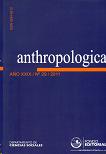
Gerardo Damonte, Isabel Gonzales y Julieta Lahud. 2016. “La construcción del poder hídrico: agroexportadores y escasez de agua subterránea en el valle de Ica y las pampas de Villacurí.” Anthropologica 34(37): 87-114.
The agro-export boom in the coastal region of Ica has caused two interrelated processes: the generation of water scarcity scenarios and the emergency of the agro-exporter group as a new social actor. The role assigned to agro-exporters in the narrative of regional development has given them a dominant position in the management of Ica water resources. This has generated a re-configuration of social and political relationships at the local space that has allowed them to be able of even contest State’s efforts to regulate groundwater use. Thus, the questions guiding this research are: how the agro-exporter group has concentrated water power in Ica? And how do they exercise this power? This paper argues that control over groundwater resources has fallen into the hands of the agro-exporter group due to their capacity to concentrate and exercise three dimensions of power: economic capacity, technical knowledge and coercion. In developing this argument, we explain how the concentration of these power dimensions has influenced in the production of water scarcity scenarios to certain groups of population, without confronting much resistance despite of it.
El boom agroexportador en la región costera de Ica ha provocado dos procesos interrelacionados: la generación situaciones de estrés hídrico y la emergencia del grupo agroexportador como un nuevo actor social. El papel asignado a los agroexportadores en la narrativa de desarrollo regional les ha concedido una posición dominante en la gestión de los recursos hídricos de Ica. Esto ha generado una reconfiguración de las relaciones sociales y políticas en el espacio local, que ha permitido que el grupo agroexportador sea incluso capaz de disputar los esfuerzos de regulación del agua subterránea del Estado. Así, las preguntas que guían esta investigación son: ¿cómo los agroexportadores han concentrado poder hídrico en Ica? ¿Cómo ejercen este poder? El artículo argumenta que el control sobre el agua subterránea ha recaído en manos del grupo agroexportador gracias a su capacidad de concentrar y ejercer tres dimensiones de poder: la capacidad económica, el conocimiento técnico y la coerción. En el desarrollo de este argumento, se explica cómo la concentración de estas dimensiones de poder ha incidido en la producción de escenarios de escasez hídrica a determinados grupos de población, sin enfrentar mayor resistencia a pesar de ello.
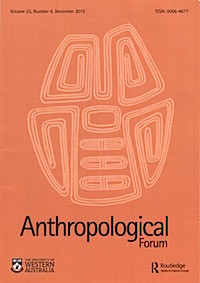
Fine-Dare, Kathleen. 2016. “Hidden Histories of Indigeneity in Urban Andean Ecuador: Transubstantiation, Ceremony, and Intention in Quito.” Anthropological Forum 26(4): 376-396.
Students of the South American Andes have long noted the extraordinary force of objects to traverse cosmic and psychic distances, fill (or empty) the living with power that is often exhibited through public dance, and serve as ‘transactors’ in senses socioeconomic, psychic, cosmic, and geographical. In this article, I examine substances and actions involved in a modified version of Holy Communion that took place in June of 2012 in a working-class neighbourhood located at the outskirts of Quito, Ecuador, to celebrate the nativity of St. John the Baptist. I argue that this act was specifically designed to expand the celebration of the Eucharist in a way that allowed a type of transubstantiation whereby the relatives and friends of former hacienda peons were able to transform their physical bodies into something some believed had long been hidden from them – their right to live in the city as persons of their own making, ones who could legitimately adopt the identity and corresponding histories, territories, and political rights of indigenous persons.
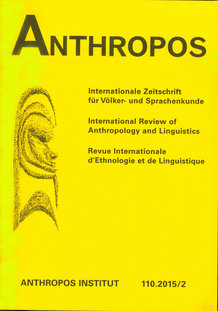
Luttmann, Ilsemargret. 2016. “Die kongolesischen sapeurs zwischen Marginalisierung und celebrity Kult.” ANTHROPOS 111: 21-47.
This article outlines the continuities and the modifications of the socio-cultural movement of the Congolese dandies, or sapeurs as they call themselves. They have become the object of extensive global media coverage in recent years. I shall argue that the sapeurs themselves made use of the digital media technology to achieve the status of stars which they used for social advancement in concordance with the logic of the local economy of prestige. Their active exploitation of global media representation is seen as a novel resource for social reproduction following the breakdown of the economy of fraud.
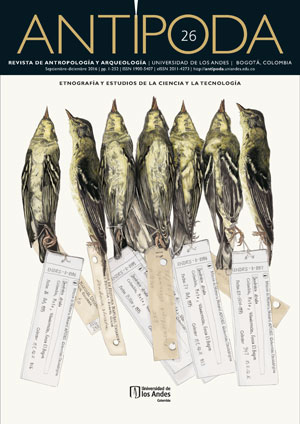
Bonelli, Cristóbal. “Palabras de piedra, materiales proféticos y políticas del dónde.” Antípoda. Revista de Antropología y Arqueología 26: 19-43.
El siguiente artículo es una reflexión sobre teoría etnográfica que se ‘inspira’ en tres intervenciones propuestas por los Estudios de Ciencia y Tecnología y, en especial, por la Teoría Actor-Red, a saber: a) el descentramiento de lo humano y el enfoque en la capacidad de las cosas para hacer política, b) la consideración de los objetos etnográficos como objetos múltiples y c) la desestabilización de la división entre dominios teóricos y empíricos. El objeto etnográfico que articula esta reflexión teórica es una piedra del sur de Chile que es capaz, en alguna medida, de: a) hacer política, b) evocar multiplicidades y c) desestabilizar la distinción entre lo teórico y lo empírico. En el intento de describir etnográficamente esta piedra, planteo la necesidad de desarrollar una sensibilidad etnográfica que no se limite a replicar las categorías analíticas de las fuentes de ‘inspiración conceptual’, sino que sobre todo desarrolle lo que llamaré heurísticamente ‘procesos de exhalación etnográfica’, entendidos como un proceso que regenera las fuentes conceptuales ‘inspiradas’. Así, busco complementar el interés ontológico de la Teoría Actor-Red sobre las ‘políticas del qué’ con el desarrollo de las ‘políticas del dónde’, constituidas por fuerzas y temporalidades plegadas en el campo etnográfico y sus tensiones ontológicas, por las características singulares del lenguaje de los actores estudiados y por los repertorios conceptuales de las disciplinas movilizadas en la escritura etnográfica.

LICONA VALENCIA, Ernesto, y Jessica SÁNCHEZ MAYORA. “BEBER, BAILAR, LIGAR. La construcción social de la noche en San Andrés Cholula, Puebla (DRINKING, DANCING, FLIRTING. The social construction of the night in San Andrés Cholula, Puebla).” Antropología Experimental 16: 443-455.
The aim of this paper is to analyze the social construction of the night through the appropriation of space that structures sociability among individuals attending the Fourteenth Street in San Andres Cholula, Puebla, characterized by the consumption of alcoholic drinks, dancing, flirting and use the body as a communication resource.
El objetivo de este artículo es analizar la construcción social de la noche a través de la apropiación del espacio que estructura la sociabilidad entre sujetos asistentes a la calle Catorce, en San Andrés Cholula, Puebla, caracterizada por el consumo de bebidas embriagantes, baile, ligue y uso del cuerpo como recurso comunicativo.

Heatherington, Tracey and Filippo M. Zerilli eds. 2016. “Anthropologists in/of the neoliberal academy.” ANUAC 5(1): 41-90.
This special Forum brings together short commentaries from anthropologists working in a variety of university settings and roles, to reflect on our immediate recent experiences with the imposition of public sector educational reforms. The contributions explore ongoing institutional transformations in Australia and New Zealand, Romania, Denmark, Greece, Finland, Mexico, US, Holland, Spain, Canada and the UK. We aim to establish a platform to host ongoing discussions about the changing nature of higher education and its implications for the future of anthropology. We are confident that these exchanges in Anuac will enable colleagues coping with the impacts of austerity to move together toward a coalition in favour of the university as we think it should be. Contributions of Cris Shore & Susan Wright, Vintilă Mihăilescu, Sarah F. Green, Gabriela Vargas-Cetina & Steffan Igor Ayora-Diaz, Tracey Heatherington, Dimitris Dalakoglou, Noelle Molé Liston, Susana Narotzky, Jaro Stacul, Meredith Welch-Devine, Jon P. Mitchell.
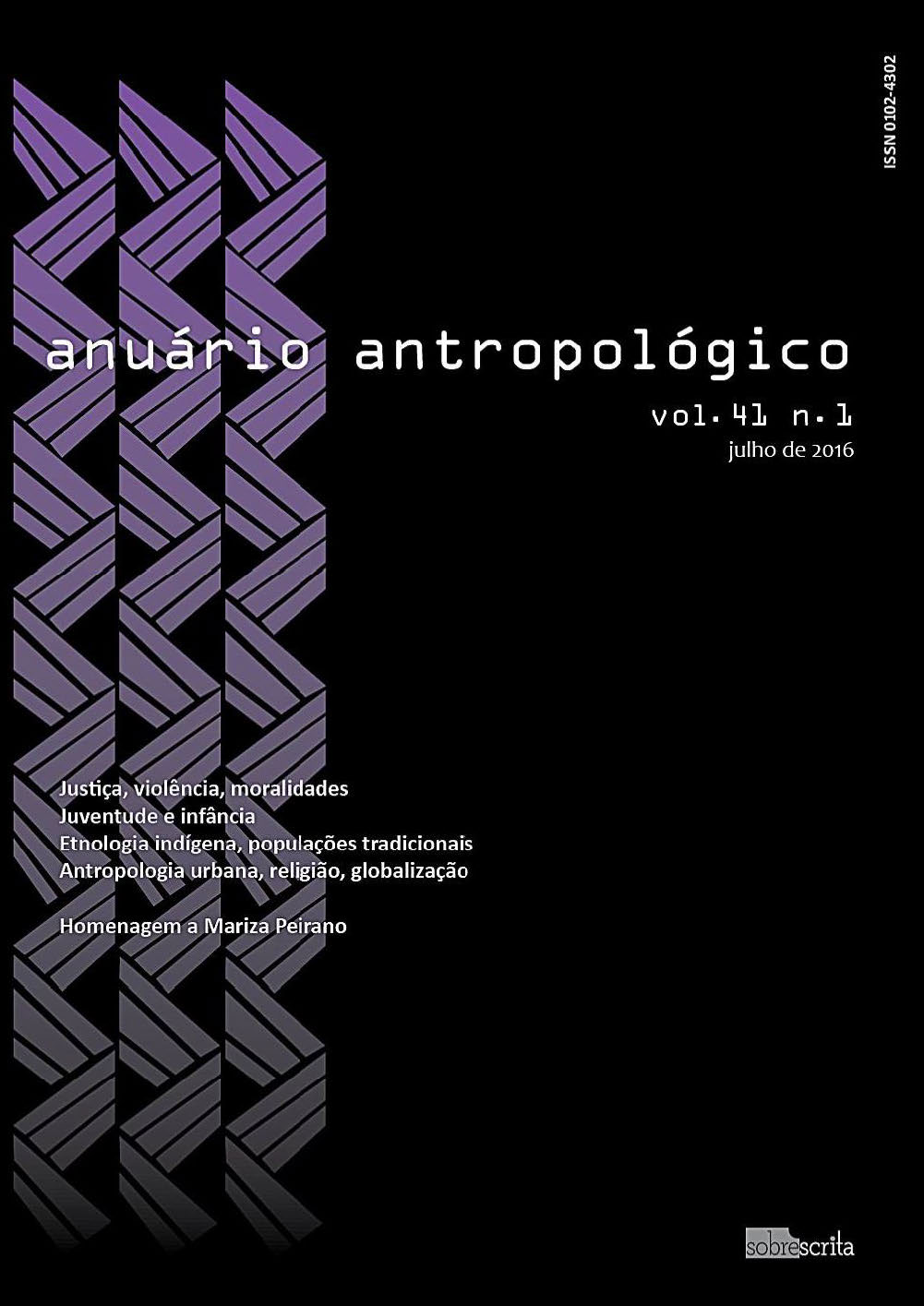
Chaves, Christine de Alencar. 2016. “Em busca de dragões. Mariza Peirano e a arte de ensinar antropologia Anuário Antropológico (The quest for dragons. Mariza Peirano and the art of teaching anthropology).” Anuário Antropológico 41(1): 283-305.
The crafts nature of the production of knowledge in anthropology turns teaching it into a kind of art. As a former student and supervisee of Mariza Peirano, a Brazilian anthropologist who has devoted her work to reflections on anthropological theory, I present the reader with Peirano's own particular approach to the art of teaching and advising. Guided by her interest in producing an anthropology of anthropology, Peirano has studied the formation and development of the discipline in Brazil and examined how it can be compared to the anthropology emerging within other national traditions. In carving a path that passes through the courses, classes and seminars that Peirano has taught, I also discuss the effects and impacts that the former have had on my own intellectual production. I examine Peirano's art of teaching in conjunction with an overview of her work, highlighting her emphasis on ethnography as an always novel encounter of theory and practice. I also point to the singular relevance that her study of rituals has had within the construction of an intellectual legacy.
A natureza artesanal da produção do conhecimento na Antropologia implica uma espécie de arte em sua transmissão. Com a antiga aluna e orientanda, o leitor é apresentado à arte de ensinar e orientar de Mariza Peirano, antropóloga brasileira que tem se dedicado à reflexão sobre a teoria antropológica e à elaboração de uma antropologia da antropologia através do estudo sobre a formação e desenvolvimento da antropologia no Brasil e sua comparação com outras tradições nacionais. Num trajeto que passa por cursos e disciplinas, aulas e seminários, ele também acompanha a relação de orientação, assim como seus efeitos e impactos na produção intelectual da autora. A arte de ensinar de Mariza Peirano é apresentada em conjunto com uma apreciação de sua obra, destacando se sua ênfase na etnografia como um encontro sempre novo entre teoria e pesquisa, bem como a relevância singular do estudo dos rituais na construção de seu legado.

Mancuso, Alessandro. 2016. “Antropologia, "svolta ontologica", politica. Descola, Latour, Viveiros de Castro (Anthropology, ontological turn, politics. Descola,Latour, Viveiros de Castro).” Archivio Antropologico Mediterraneo 18(2): 97-132.
With the aim of a critical assessment, the paper deals with how the political dimension is configured in the theoretical approaches of Descola, Latour and Viveiros de Castro, as acknowledged leaders of the so-called “ontological turn” in human sciences during the last twenty years. This configuration is examined by two points of view: the role played by the political and power relations in the three scholars’ theories of the social, and the political implications that can be drawn from these lasts. The essay highlights the need to distinguish among, on one side, Descola’s approach, in which the political and power relations are features belonging to another level than that one of the logic of structuration of “ontologies” and ethos, even though influencing dominance of some modes rather than others as much as their historical changes; from the other side, Latour and Viveiros de Castro’s approaches, in which ontology and politics are directly linked. In all these cases, these approaches does not account for the complexity of factors, which mediate the relationships between ontology and politics, this generally being a blind spot for the “ontological turn”.
Il testo esamina, con un intento di valutazione critica, la configurazione della dimensione politica negli approcci teorici di Descola, Latour e Viveiros de Castro, considerati i capifila del cosiddetto ontological turn nelle scienze umane degli ultimi vent’anni. Questa configurazione è analizzata da due punti di vista: il ruolo giocato dal politico e dai rapporti di potere nelle teorie del sociale proposte dai tre studiosi, e le implicazioni politiche che essi annettono alle loro teorie. Si sottolinea la differenza tra l’approccio di Descola, in cui il politico e i rapporti di potere sono considerati elementi appartenenti a un piano diverso dalla logica di strutturazione delle “ontologie” e degli ethos che tuttavia influenzano la dominanza di alcuni modi piuttosto che altri e la loro dinamica storica di cambiamento, e gli approcci di Latour e Viveiros de Castro nei quali i nessi tra ontologia e politica sono intrinseci. In tutti e tre i casi, si argomenta che questi approcci teorici non rendono conto della complessità di fattori che mediano le relazioni tra ontologia e politica, e che ciò rappresenta più in generale un punto cieco dell’ontological turn.

Chen, Siyu. 2016. “Negotiating masculinities through the game of distinction - a case study of MOBA gamers at a Chinese university.” Asian Anthropology 15 (3): 242-259.
MOBA games – a major site for male bonding – have gained wide popularity in Chinese universities. However, college gamers in general suffer from stigmatization as game addicts and this challenges their senses of masculinity. Based on four months of field study, this article investigates the formation of MOBA gamers’ masculinities through diverse game-related practices and discourses, with a particular focus on its intersection with class. Building on Tony Coles’ theoretical model of “a field of masculinity,” the article concludes that MOBA games constitute an arena where performances of social class, and recognition of class entitlements, are enacted and coded in a highly gendered way. Arguing that the masculine hierarchy in MOBA gaming culture is not so much about the MOBA games themselves but rather a “game of social distinction,” this article gives insight into how masculine culture in contemporary China is informed by increasing materialism and social stratification.

Noel, Gabriel D.. 2016. “VERDADES Y CONSECUENCIAS. LAS INTERPELACIONES ÉTICAS EN LAS LECTURAS NATIVAS DE NUESTRAS ETNOGRAFÍAS.” AVÁ 28: 101-126.
Reflections about the ethical challenges implied in ethnographic fieldwork have a long history in the debates within our discipline. A path less followed involves questioning the ways in which certain decisions on the part of the researcher bring about scenarios in which our relationships with different kinds of research partners is tested within the framework of ethical questions arising from our partners themselves. In light of these considerations, we present and discuss some reactions provoked by our ethnographic research among our partners in the field in order to bring into sharp relief the duality between the methodological and the ethical dimensions implied in those readings.
Las reflexiones en torno de los desafíos éticos inherentes al trabajo etnográfico reconocen una larga genealogía en los debates de las ciencias sociales. Menos frecuentado en la literatura etnográfica resultan las indagaciones sobre los modos en que ciertas decisiones del investigador configuran escenarios en los cuales nuestra relación con diversas clases de interlocutores es puesta a prueba en el marco de una interpelación ética por parte de ellos. A la luz de estas consideraciones, procederemos a presentar y discutir un conjunto de reacciones suscitadas entre nuestros interlocutores en el campo por nuestra producción etnográfica, con el objeto de poner de relieve la dualidad entre las dimensiones metodológicas y las éticas involucradas en esas operaciones de lectura.
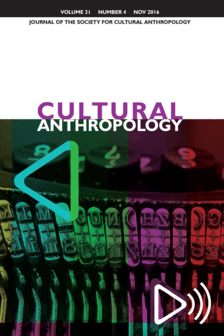
Thorkelson, Eli. 2016. “THE INFINITE ROUNDS OF THE STUBBORN: Reparative Futures at a French Political Protest.” Cultural Anthropology 31(4): 493-519.
When social actors find themselves at an impasse, perceiving their futures as threatened, how can they respond? If their futures can get broken or interrupted, can they subsequently be reconnected or repaired? If yes, how? Here, I consider an ethnographic case of reconnected futurity drawn from French protest politics: the 2009–2010 Ronde Infinie des Obstine ́s, or “Infinite Rounds of the Stubborn.”Opposing Sarkozy-era neoliberal university reforms, the Ronde sought to instrumentalize its temporal and political impasse, shifting its relation to the future out from the register of subjectivity and into the register of ritual motion. By situating the Ronde within the fabric of Parisian political space, I show how it synthesized the politics of occupation with the politics of marching, hopelessness with stubborn endurance, the negation of state temporality with the prefiguration of an alternative future. I conclude by reflecting on the place of temporal repair in relation to recent forms of prefigurative radicalism.
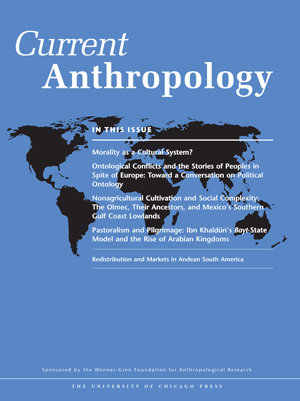
Wilf, Eitan. 2016. “The Post-it Note Economy.” Current Anthropology 57(6): 732-760.
This essay seeks to clarify an undertheorized dimension of capitalism’s transition to post-Fordist flexible accumulation—namely, the “acceleration in the pace of product innovation” (Harvey 1990:156). Based on ethnographic fieldwork in innovation workshops organized in New York City by consultants and attended by business entrepreneurs, this essay argues that whereas cutting-edge technologies such as computerized algorithms and robotic technologies dominate many post-Fordist production and distribution systems, the Post-it note—a small rectangular piece of paper with weak adhesive properties—looms large as a key semiotic technology of idea generation in many contemporary business-innovation contexts for two reasons: (1) its small dimensions afford pragmatic ambiguity and consequently the decoupling of data from the reality of the market under the guise of its reflection, and (2) its weak adhesive properties afford the synoptic arrangement of such pseudodata on conventional visual templates of what a valid insight should look like and thus the quick production of ritual insights. In doing so, the essay builds on and contributes to recent semiotic and linguistic anthropological studies that have paid close attention to the role played by graphic artifacts in organizational knowledge production.
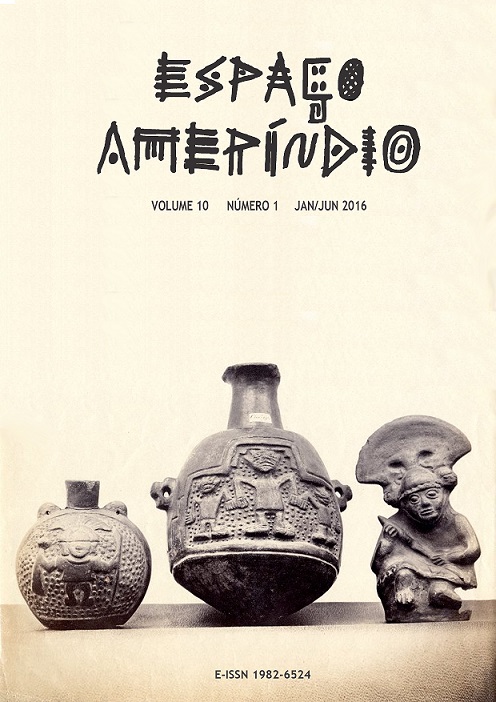
Araújo, Danielle. 2016. “AGOUROS DE UM ESPELHO PARTIDO: LUTA E RESISTÊNCIA NO PROCESSO DE AFIRMAÇÃO ÉTNICA DOS ÍNDIOS DO NORDESTE–O CASO DOS TAPUIAS–KARIRIS DE SÃO BENEDITO.” Espaço Ameríndio 10(1): 61-77.
The purpose of this article is to present part of field research on the ethnic affirmation process of the Tapuias-Kariris from São Benedito ─ an indigenous collective community in Ceará/Brazil. The analysis results from an ethnography among Tapuias and observations conducted with others indigenous communities from Ceará. The Tapuias-Kariris are the latest group to self declare themselves as indigenous. In the process of self-affirmation and recognition, the first challenge faced by the group is the social refusal to recognize them as indigenous. Faced with this rejection, the group is constantly negotiating and affirming their identity. This process is performed through the reworking of the images, the material culture and cultural practices, collective elements that are now designed by the prism of ethnic belonging. Material culture and the set of practices and knowledge incorporated have a central role in the daily life of these indigenous groups. Arising from ancestral knowledge, the objects, as well as dances, songs and rituals, narrate the life and cosmological conception in a particular way. Analyzing the process of affirmation, its inherent difficulties, as well as the role of cultural events and images, is the objective of this work.
Este artigo tem como propósito apresentar parte da pesquisa de campo sobre o processo de afirmação étnica dos Tapuia-Kariri de São Benedito ─ comunidade coletiva indígena do estado do Ceará. A análise resulta de uma etnografia entre os Tapuias e das observações realizadas junto a outras comunidade indígenas do Ceará, na condição de docente do magistério indígena da Secretária de Educação do Estado do Ceará (SEDUC). Os Tapuias-Kariris constituem o grupo mais recente a autoafirmar-se como indígena. No processo de autoafirmação e reconhecimento, a primeira dificuldade que o grupo enfrenta é a negação social em reconhecê-los enquanto indígenas. Diante dessa rejeição, o grupo está constantemente negociando e afirmando sua identidade. Esse processo é realizado por meio da reelaboração das imagens, da cultura material e das práticas culturais, elementos coletivos que passam a ser concebidos pelo prisma de pertença étnica. A cultura material e o conjunto de práticas e de saberes a ela incorporada ocupam um lugar central no cotidiano desses grupos indígenas. Advindos de conhecimentos ancestrais, os objetos, assim como as danças, as músicas e os rituais, narram de modo particular a vida e a concepção cosmológica. Analisar o processo de afirmação, suas dificuldades intrínsecas, bem como o papel das manifestações culturais e das imagens, é o objetivo deste trabalho
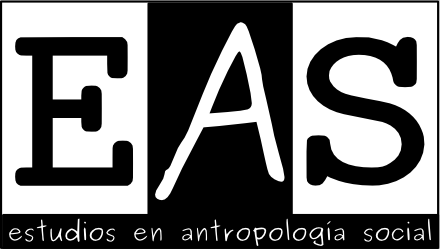
Weiss, Mariana Tello. 2016. “Historias de (des)aparecidos. Un abordaje antropológico sobre los fantasmas en torno a los lugares donde se ejerció la repression poltica (Stories of the (dis)appeared. An anthropological approach on the apparitions of ghosts in places where political repression was exercised).” Estudios en Antropología Social 1(1): 33-49.
This article approaches from an anthropological perspective the ghost stories about places where repression was exercised during the last military dictatorship in Argentina (1976-1983). The "extraordinary events" and its ontological consideration not only put in tension both nodal epistemological debates in anthropology (such as modernity vs. postmodernism, with the consequent tension between reality and fiction) as ethical and political debates (such as the tension between relativism and ethnocentrism), but also challenge the researcher's reflexivity. Located at these crossroads, the challenges posed by the "extraordinary events" and the narratives about ghosts are good to think about certain structural issues of the discipline. This analysis also intends to be a contribution to (re)think the political disappearances as a social problem from the edges —that is, from the "unspeakable", taking into account particularly those agents and versions of the past that are less legitimized—, in order to examine the emotional force that the disappearance has for these groups and its current social significance.
Este artículo aborda desde una perspectiva antropológica las historias de fantasmas o espectros referidas a los lugares donde se ejerció la represión durante la última dictadura militar en Argentina (1976-1983). Los “eventos extraordinarios” y su consideración ontológica tensionan tanto debates epistemológicos nodales dentro de la antropología (como modernidad vs. posmodernidad, con la consiguiente tensión entre realidad y ficción) como debates ético/políticos (como la tensión entre etnocentrismo y relativismo), e interrogan singularmente la reflexividad del investigador. Por situarse en estas encrucijadas, los desafíos que los “eventos extraordinarios” y las narrativas sobre fantasmas plantean resultan buenos para pensar ciertos tópicos estructurales de la disciplina. Este análisis también pretende ser una contribución a (re)pensar la desaparición política como problema social desde los bordes, desde aquellos agentes y versiones sobre el pasado menos legitimados, desde lo “indecible”, para desde allí examinar la fuerza emocional de la desaparición para estos grupos, y sus alcances sociales en la actualidad.

Smørholm, Sesilie. 2016. “Suffering Peacefully: Experiences of Infancy Death in Contemporary Zambia.” ETHOS 44(3): 333-351.
In Ng’ombe Township in Lusaka, the death of a baby is often met with silence. Based on long-term ethnographic fieldwork, this article explores how the bereaved mother’s silence is guided by wider cultural norms and values associated with death, by complex notions of what it means to be a person, and by local perceptions of mental health and well-being. To enhance the complexity of the mother’s silences, it also explores how structures of poverty manifest in mothers’ experiences of loss and how silence may hold feelings of inadequacy but also of care and compassion. Finally, the article aims to provide a counterweight to the predominant assumption that mothers in poor communities, who experience high levels of infant mortality, fail to mourn the death of their babies, as well as to psychological theories that assumes verbal expressions as vital for the mourner’s mental recovery after loss.
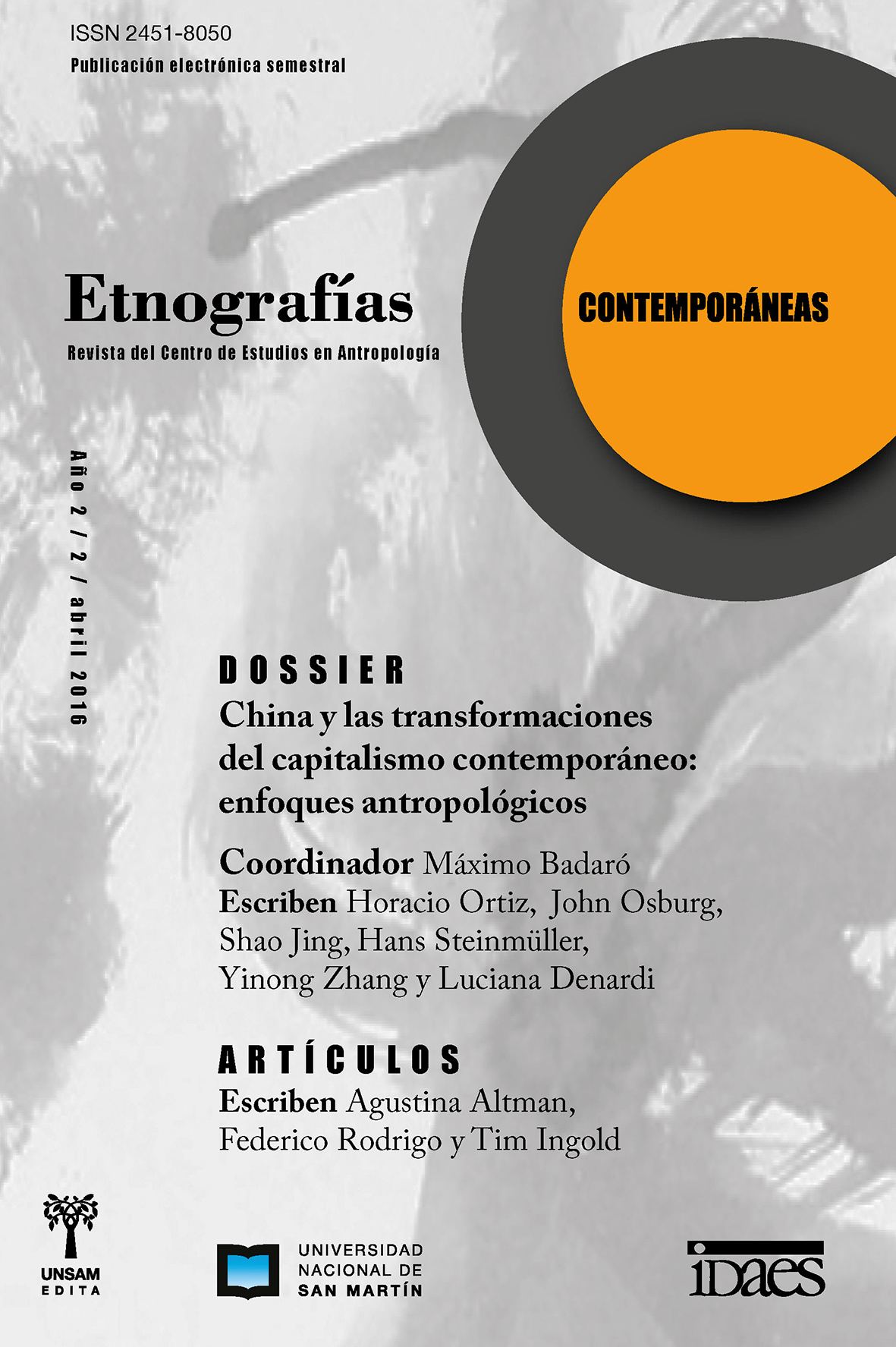
Salamanca Villamizar, Carlos y Astudillo Pizarro, Francisco (2016). “Justicia(s) espacial(es) y tensiones socio-ambientales. Desafios y posibilidades para la etnografia de un problema transdisciplinario (Spatial Justice (s) and socio-environmental tensions: Challenges and possibilities for an ethnography of a transdisciplinary debate)”. Etnografias Contemporaneas 2 (3): 24-54.
In this article we discuss some of the debates which address the concept of spatial justice in relation to contemporary ethnographies. First, we present a discussion about the multiple ways in which the different dimensions of spatial justice have been studied. Secondly, we highlight some of the main themes of research regarding the notion of spatial justice and the environment. Finally, we highlight some contributions and methodological challenges in relation to “ethnographic practices” identifying developments and limitations from a comparative perspective. Hence, we emphasize some of the aspects in which ethnography is responding to the challenges of the complex contemporary world in which space and society are interwoven.
En este trabajo ponemos en dialogo algunas de las discusiones sobre la nocion de justicia espacial con algunas de las llamadas etnografias contemporaneas. En la primera parte presentamos una discusion acerca de las formas en que han sido abordadas algunas dimensiones de la justicia espacial. Posteriormente, destacamos algunas de las principales lineas de investigacion que pueden identificarse en torno a la tematica de la justicia espacial vinculadas al medioambiente. Finalmente, subrayamos algunos aportes y desafios metodologicos en torno a las “practicas etnograficas”, identificando sus desarrollos y dificultades en clave comparativa. Para esto, subrayamos algunos ejes a traves de los cuales la etnografia viene respondiendo a los desafios de la complejidad contemporanea en la que espacio y sociedad se encuentran imbricados.
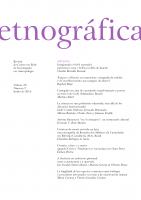
Rezende, Claudia Barcellos. 2016. “Imaginando o bebê esperado: parentesco, raça e beleza no Rio de Janeiro.” Etnográfica 20(2): 231-249.
Neste artigo, discuto a gestação como momento de revalidação e atualização dos laços de parentesco. A partir de narrativas de gestantes de camadas médias no Rio de Janeiro, analiso o modo como imaginam a aparência física de seus bebês recorrendo aos traços físicos de suas famílias. Pensar no bebê esperado é uma instância de negociação com as identidades continuadas que vêm do passado, no momento em que se veem diante do futuro, projetando para o filho ou filha características, identidades e laços sociais. Neste processo, a associação entre parentesco e semelhança física é problematizada, na medida em que a continuidade física entre as gerações pode ou não ser desejada. Noções de beleza, raça e classe presents na sociedade brasileira interferem no modo como o bebê esperado é imaginado. A continuidade entre as gerações que é desejada surge então menos como uma reprodução e sim como conexões “aperfeiçoadas”, destituídas dos traços indesejados.

Murphy, Daniel, Carina Wyborn, Laurie Yung, Daniel R Williams, Cory Cleveland, Lisa Eby, Solomon Dobrowski, and Erin Towler. 2016. “Engaging Communities and Climate Change Futures with Multi-Scale, Iterative Scenario Building (MISB) in the Western United States.” Human Organization 75(1): 33-46.
Current projections of future climate change foretell potentially transformative ecological changes that threaten communities globally. Using two case studies from the United States Intermountain West, this article highlights the ways in which a better articulation between theory and methods in research design can generate proactive applied tools that enable locally grounded dialogue about the future, including key vulnerabilities and potential adaptive pathways. Moreover, anthropological knowledge and methods, we find, are well-suited to the complexities and uncertainties that surround future climate change. In this article, we outline a narrative-driven assessment methodology we call multi-scale, iterative scenario building (MISB) that adheres to four key principles: (1) meaningful integration of socioecological interactions, (2) engagement with uncertainty, (3) awareness and incorporation of dynamic spatial and temporal scales, and (4) inclusion of diverse knowledge(s) from both social and natural sciences as well as from communities, including skeptics and deniers. The research found that MISB illuminated the complex, relational nature of vulnerability and adaptation and provided significant insight into potential, and sometimes surprising, future conflicts, synergies, and opportunities. We also found that MISB engendered a deep appreciation among participants, even skeptics and deniers, about the numerous, multi-scaled feedbacks and path dependencies generated by interacting drivers of social and ecological change. In conclusion, we argue this approach provides substantial space for the reflexive learning needed to create the “critical emancipatory knowledge” required in the face of transformational threats likeclimate change, and as such, we suggest potential avenues to support planning and decision making in the face of uncertain futures.
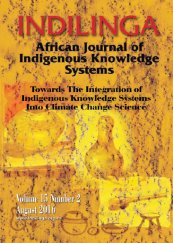
Mkabela, Queeneth Nokulunga. 2016. “Ubuntu as an Axiological Framework for Human Rights Education.” Indilinga: African Journal of Indigenous Knowledge Systems 13(2): 283-291.
Increasing awareness has been drawn, in recent years, to the flaws of culturally irrelevant human rights education. Several factors, including a general lack of a culturally appropriate approach, a lack of integration of indigenous values, and the failure to provide human rights education that is responsive to community perspectives, have created a gap between the conceptualisation and practice of human rights by indigenous communities. So widespread is this feeling that parents are beginning to abdicate their roles of instilling values to their children and are blaming the system of education for introducing human rights education in schools which encourages unacceptable behaviour in communities. This article is concerned with a critical discussion and analysis of the key tenets of ubuntu and attempts to show how these can be utilised as an axiological framework for human rights education in South Africa.

Faleye, Olukayode A. 2016. “Toward a Historical Archaeology of West African Borderlands.” International Journal of Modern Anthropology 1(9): 77-89.
The duo-field of historical archaeology is increasingly being recognized around the world for its contributions. However, most of the existing surveys have concentrated on the coastal and hinterland locations in West Africa. Whereas, the ethnographic cum archival study of West African borderlands abounds in the literature, there is the dearth of the comparative analysis of these sources in tandem with the archaeological findings of material culture. Thus, this paper seeks to open up a new dialogue on the importance of borderlands studies in historical archaeology and vice versa. It concludes that the historical archaeology of West African borderlands promises to yield new insights into the dynamics of the region’s modern history.
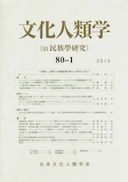
Nara, Masashi. 2016. “Autonomy in Movement: Informal Islamic Pedagogical Activities among Hui Muslims in China.” Japanese Journal of Cultural Anthropology 80(3): 363-385.
This paper examines how Hui Muslims can assure religious autonomy from the contemporary Chinese state that strictly controls religions. Specifically, it focuses on processes whereby Hui Muslims carry out informal and highly mobile Islamic pedagogical practices in Kunming, Yunnan Province. A rapid revival of religion has occurred in China because of the abatement of religious policies in the post-Mao Chinese state. However, religious policies have still been strict. Therefore, there have been conflicts between religious groups and Chinese authorities. Recent studies of the religious revival in China have tended to interpret it with an assumption that it is possible for religious groups to expand autonomy through political action either against the state or within it, such as resistance, institutionalization, etc. However, this paper sheds light on the Hui Muslims' practices that do not involve political action against the state or direct negotiation with the authorities. Rather, they are inclined to evade such politics. Informal Islamic pedagogical activities of Hui Muslims are highly unstable because such activities are in constant danger of prompting the policing and enforcement of governmental regulations. Given this situation, participants often temporarily suspend their activities to shift location and change the ways their activities are delivered to dodge governmental regulations. In sum, instead of direct and situated resistance to the state, religious teaching and learning practices have become a ceaseless flight from state power. However, through such activities it is impossible to change the dominant structures of the state. Moreover, people involved in these religious practices are mobile and their associations fragile because they are always faced with possible government intervention. Nevertheless, and somewhat paradoxically, this is precisely why the activities of Hui Muslims cannot be completely suppressed by the government. It is because of such constant movement that the propagation of Islam continues effectively, if intermittently. Indeed, autonomy for Hui Muslims is often found in such constant movement.
本論文は、中国雲南省の首府・昆明市における回族の人びとによるインフォーマルなイスラーム教育活動の事例から、現代中国における回族の自律性のあり方を論じることを目的とする。1978年に「改革・開放」政策が導人されて以降、中国ではそれまでの暴力的な宗教政策が緩和され、宗教が急激に復興してきた。しかし、一方で中国政府は宗教に対する厳格な管理統制を続け ており、しばしば当局と宗教集団とのあいだでコンフリクトが起きてきた。先行研究では、同時期の宗教復興を国家による宗教の管理制度を前提とした、宗教集団と国家やその他の諸アクターとの問でのポリティクスとして捉える傾向にあった。そのなかで、宗教復興は、宗教集団の中国政府に対する抵抗、あるいは宗教の制度化として論じられた。それに対して、本論文で提示する事例から明らかになるのは、インフォーマルな宗教活動を担う回族の人びとが国家と宗教集団を対立軸とするポリティクスを志向せず、むしろそれを回避していく実践である。インフォーマルな宗教活動はしばしば当局による取り締まりを受けるが、その際、彼らは当局に抵抗や抗議するのではなく、活動を中止するe しかし、そのうえで、彼らは取り締まりを受けにくい新たな形式で活動を再開していくのである。本論文では、こうした回族の人びとによる活動の一連のプロセスを検討することを通して、国家への抵抗、国家との交渉といったポリティクスに依らない、不断の動きのなかで立ち現れる回族の自律性のあり方を考察する。

Lieberman, Philip. 2016. “The evolution of language and thought.” Journal of Anthropological Sciences 94: 127-146.
Language primarily evolved as a vocal medium that transmits the attributes of human culture and the necessities of daily communication. Human language has a long, complex evolutionary history. Language also serves as an instrument of thought since it has become evident that in the course of this process neural circuits that initially evolved to regulate motor control, motor responses to external events, and ultimately talking were recycled to serve tasks such as working memory, cognitive flexibility linguistic tasks such as comprehending distinctions in meaning conveyed by syntax. This precludes the human brain possessing an organ devoted exclusively to language, such as the Faculty of Language proposed by Chomsky (1972, 2012). In essence like Fodor’s (1983) modular model, a restatement of archaic phrenological theories (Spurzheim, 1815). The subcortical basal ganglia can be traced back to early anurans. Although our knowledge of the neural circuits of the human brain is at a very early stage and incomplete, the findings of independent studies over the past 40 years, discussed here, have identified circuits linking the basal ganglia with various areas of prefrontal cortex, posterior cortical regions and other subcortical structures. These circuits are active in linguistic tasks such as lexical access, comprehending distinctions in meaning conferred by syntax and the range of higher cognitive tasks involving executive control and play a critical role in conferring cognitive flexibility. The cingulate cortex which appeared in Therapsids, transitional mammal-like reptiles who lived in age of the dinosaurs, most likely enhanced mother-infant interaction, contributing to success in the Darwinian (1859) “Struggle for Existence”– the survival of progeny. They continue to fill that role in present-day mammals as well as being involved in controlling laryngeal phonation during speech and directing attention (Newman & MacLean, 1983; Cummings, 1993). The cerebellum and hippocampus, archaic structures, play role in cognition. Natural selection acting on genetic and epigenetic events in the last 500,000 years enhanced human cognitive and linguistic capabilities. It is clear that human language did not suddenly come into being 70,000 to 100,000 years as Noam Chomsky (Bolhuis et al., 2014) and others claim. The archeological record and analyses of fossil and genetic evidence shows that Neanderthals, who diverged from the human line at least 500,000 years ago possessed some form of language. Nor did the human population suddenly acquire the capability to relate two seemingly unrelated concepts by means of associative learning 100,000 years ago, re-coined “Merge” by Chomsky and his adherents, Merge supposedly is the key to syntax but associative learning, one of the cognitive processes by which children learn languages and the myriad complexities of their cultures, is a capability present in dogs and virtually all animals.

Ermel, Marje. 2016. “Searching for the Hidden God: The Intimacy of Sound and Listening among Krishna Devotees in Mayapur.” Journal of Ethnology and Folkloristics 1(1): 3-24.
This article looks at how the Krishna devotees in Mayapur, West Bengal, learn how to chant and listen to the sound of the holy name properly. They suggest that if one is ‘pure’ enough and knows how to listen one experiences the syneasthetic level of sound called pashyanti. At this level, one can reach beyond the duality of the ‘hidden and manifested’ worlds, the external and internal levels of sound; and one can ultimately see God face to face. This is also considered a level at which one can realise that the sound of God’s name and God himself are the same. I will focus on how the devotees learn to create this sense of intimacy with God through the sound of his holy name, and argue that listening is not merely a process connected to our auditory sense but rather a creative and engaging activity, a skill that one can develop.
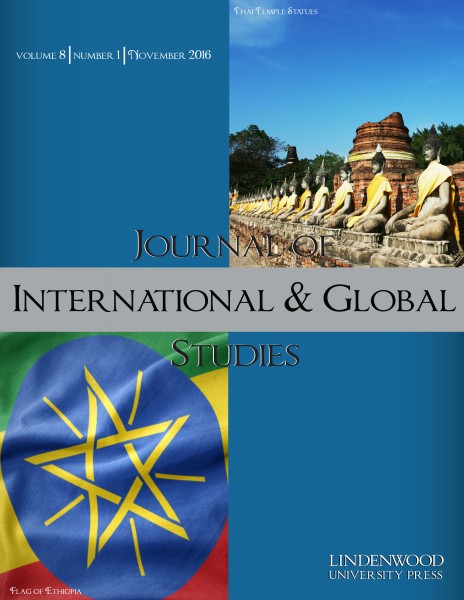
Tefera, Goshu Wolde and A. Peter Castro. 2016. “Flag Politics in Ethiopia and the Ethio-American Diaspora.” Journal of International and Global Studies 8(1): 1-20.
Flags hold “rich symbolic and political connotations,” yet the examination of their use has been “relatively neglected in research on nationalism” (Eriksen, 2007, p. 1-2). Our study explores the transnational politics of Ethiopia’s national flag, exploring its manifestation within the Ethio-American community in the Washington, DC metropolitan area, where the largest Ethiopian diaspora population in the United States resides. We also examine the historical roots of Ethiopian flag politics within Ethiopia’s historical political economy. The country’s well-known imperial flag, containing the emblem of the Lion of Judah against green, yellow, and red stripes, emerged by the late 19th century as Ethiopia defended itself against colonial intrusion. The flying of the flag, an essentially invented tradition, was originally used to reinforce the legitimacy of Ethiopia’s imperial elite. Ultimately, however, flags—all flags—became associated with deep patriotic meaning. The tricolor stripes of the imperial of the flag became an important Pan-African and anti-colonial symbol after the country’s resistance to Italian occupation during the first part of the twentieth century. Later, a plain tricolor flag of green, yellow, and red, without the Lion of Judah, was used by the Derg—the collective of military and police forces that deposed Emperor Haile Selassie in 1974, imposing socialist rule under the leadership of Mengistu Haile Mariam, until 1991. The Ethiopian People’s Democratic Revolution Front (EPRDF), which came to power in 1991, has promoted its own national flag, marked by an emblem symbolizing its vision of an ethnic federalism based on the self-determination of the country’s ethnic and religious populations. The authority of the EPRDF has been challenged both by Ethiopian nationalists—who see ethnic federalism as fragmenting the country’s long-standing national coherence—and by the peoples on Ethiopia’s margins, who have been frustrated by the EPRDF’s unwillingness to devolve authority to them. The severe reaction of the EPRDF against its opposition hardened political identities and stances. This conflict culminated in the declaration of a state of emergency on October 9, 2016. The political tensions within Ethiopia are displayed and played out within Ethiopia’s diaspora, which is one of the fastest growing African immigrant populations in the United States. This study draws on the 2015 fieldwork of Goshu Wolde Tefera, conducted in the Washington, DC area, as well as on the library- and internet research carried out by Tefera and A. Peter.
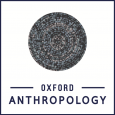
Stellmach, Darryl and Isabel Beshar. 2016. “Introduction: the ethics of anthropology in emergencies.” Journal of the Anthropological Society of Oxford 8(1): 1-15.
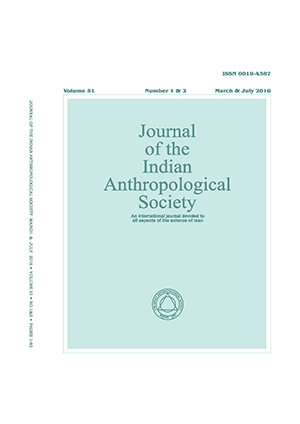
Mene, Tarun and Sarit K. Chaudhuri. 2016. “Euthanasia among the Idu Mishmis of Arunachal Pradesh: Understanding Issues and Concerns of a Frontier Tribe.” Journal of the Indian Anthropological Society 51: 24-40.
In the present paper, the authors bring an account of the historical and cultural aspects of euthanasia as existed among the Idu Mishmi tribe of Arunachal Pradesh. It addresses the practical issue of management in which the family members of the victim had to make difficult decisions when faced with a person expressing a wish to die. Focusing on case studies on different forms of euthanasia the paper has tried to understand how, when and why an Idu Mishmi desire for such distinct form of dying. An attempt has also been made to extract how the attitudes toward such practice have varied over time and space. Perhaps, in the entire northeast India, the Idu Mishmis are the only tribal group which practiced euthanasia in its own uniquely rudimentary form much before it came to be known to the modern world.
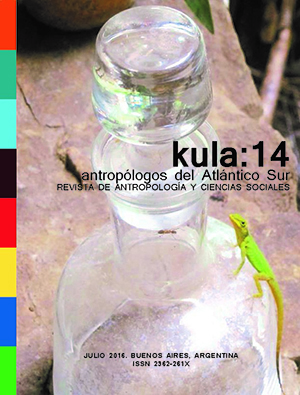
Zapata, María Constanza Casalderrey. 2016. “¿INTERÉS COMÚN? BOSQUES NATIVOS Y SERVICIOS AMBIENTALES EN DISPUTA JUDICIAL: UN CASO DEL CHACO SALTEÑO.” KULA. Antropólogos del Atlántico Sur 14: 40-54.
The paper analyzes the construction of a common interest in the understanding that it constitutes a fundamental element in the socio-environmental configuration of a conflict. I resort to a conflict that confronted indigenous and peasant communities of the north of Salta Province with sectors of provincial and national government in regards to the increase of forest clearings that took place during 2007 while the “Native Forest National Law”, n°26331, was being debated at Congress. The case reveals the existence of conflicts that put into question not only land and resource property, but the definition of a ‘common interest’ regarding the use and/or preservation of native forests. I argue that the law stablishes a concept of ‘environmental services’ that legitimizes government practices and discourses that promote new ways of nature valuation, thus allowing new forms of territorial appropriation. I refer to this process as communalization.
El trabajo analiza la construccion de un interes comun en tanto constituye un elemento fundamental alrededor del cual un conflicto se reconfigura en terminos socio-ambientales. Para ello parto de un conflicto que enfrento a comunidades indigenas y campesinas del norte de la provincia de Salta con sectores del gobierno provincial y nacional por el incremento de los desmontes suscitados en el contexto de implementacion de la Ley Nacional de Bosques N° 26331, sancionada en el ano 2007. El caso manifiesta la existencia de conflictos que disputan no solo la propiedad de la tierra y los recursos naturales, sino tambien la definicion del ‘interes general’ respecto al uso y/o preservacion de los bosques nativos. Sostengo que la ley instaura un concepto de “servicios ambientales” que legitima discursos y practicas gubernamentales que promueven nuevos criterios de valorizacion de la naturaleza, permitiendo nuevas formas de apropiacion territorial que denomino como proceso de comunalización.
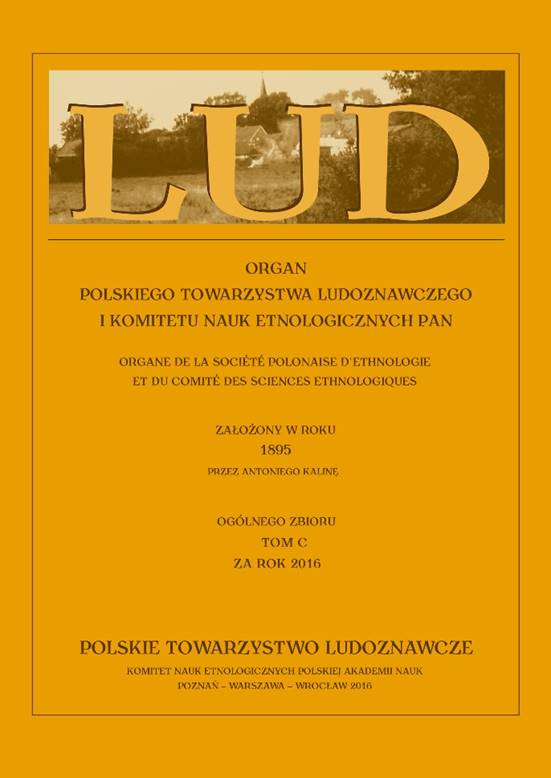
Majbroda, Katarzyna. 2016. “POSTMODERNISTYCZNE OTWARCIE W POLSKIEJ ANTROPOLOGII SPOŁECZNO-KULTUROWEJ. PROJEKT URZECZYWISTNIONY? (THE POSTMODERN OPENING IN POLISH SOCIO-CULTURAL ANTHROPOLOGY. A PROJECT REALISED?).” Lud 100: 161-184.
The aim of this paper is attempt to show the postmodern opening in the Polish ethnology. On the one hand, the text shows that the character of ‘Polish’postmodernism was shaped over the course of the accelerated reception of theory and concepts formulated in international anthropology two decades earlier. On the other hand, the article stresses that postmodernism – understood as a condition of socio-cultural reality, but also as a general context of the trends and currents of thought arising from the criticism of negatively valued modernism – sharpened and delineated intuitions and trends, as well as existing theories. This postmodern opening, which took place in anthropology at the ontological, epistemological and meta-discursive levels, covered not only the anthropological literature, but also had an impact on the rethinking of field research and on the related research practices. This was also an important stimulus for “self-reporting” in anthropology, which proved to be a significant development not only for increasing the self-awareness of researchers, but also for redefining their proposed cognition.
Celem artykułu jest próba pokazania postmodernistycznego otwarcia w polskiej etnologii. Z jednej strony, tekst pokazuje, że postmodernizmu „po polsku” kształtowałswoją postać w toku przyspieszonej recepcji teorii i konceptów formułowanych w antropologii światowej nawet dwie dekady wcześniej. Z drugiej jednak strony, artykułpodkreśla, że postmodernizm rozumiany jako kondycja rzeczywistości społeczno-kulturowej, ale także ogólny kontekst nurtów i prądów myślowych wyrastających z krytyki negatywnie waloryzowanego modernizmu wyostrzył i nazwał intuicje, tendencje, ale także już wcześniej wypracowywane teorie. Postmodernistyczne otwarcie, jakie dokonało się w antropologii na poziomie ontologicznym, epistemologicznym i metadyskursywnym, objęło swym zasięgiem nie tylko piśmiennictwo antropologiczne, ale miało także wpływ na ponowne przemyślenie badań terenowych i powiązanych z nimi praktyk badawczych. Stanowiło to także istotny bodziec dla samoopisu” antropologii, co okazało się niebagatelnym doświadczeniem nie tylko dla wzrastającej samoświadomości badaczy, ale także dla zredefiniowania proponowanego przez nich poznania.
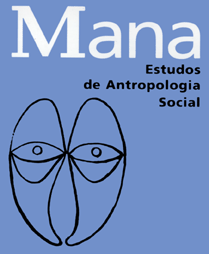
Segata, Jean. 2016. “QUANDO O ANIMAL DURA MAIS QUE A ESTIMAÇÃO (WHEN THE PET OUTLASTS COMPANIONSHIP).” Mana 22(3): 831-856.
The study of human-animal relations has been conspicuous in contemporary anthropology. It has developed along two complementary fields, one political and the other epistemological. The first involves activism and new social movements concerning the rights and moralities of animals, while the other questions and reframes the distinctions between animals and humans. In this article, I address these issues by investigating a moral dilemma involving an old, sick dog that, after spending its life as part of a human family, had to be euthanized and ultimately became blood stock for a veterinary clinic. Physicality and morality are mobilized contingently in this research context, both to identify and differentiate humans and animals and to compose and decompose a pet.
O estudo das relações humano-animal tem formado um campo que ganha boa expressão na antropologia contemporânea. Ele se desenvolve a partir de duas frentes de discussão que se complementam – uma política e outra epistemológica. A primeira envolve ativismos e novos movimentos sociais em torno de direitos e de moralidades dos animais, enquanto a outra passa a questionar e a reposicionar qualidades e distinções entre eles e os humanos. Neste trabalho, eu procuro abordar estas questões por meio de um dilema moral que envolve uma cadela velha e doente, que depois de uma vida como parte de uma família humana, foi encaminhada para eutanásia e terminou transformada em estoque de sangue de uma clínica veterinária. Fisicalidade e moralidade são mobilizadas de forma contingente nesse contexto de pesquisa, tanto para equivaler e diferenciar humanos e animais como para compor e decompor um animal de estimação.
El estudio de las relaciones entre humanos y animales se ha conformado como un campo prolífico en la antropología contemporánea. Se desarrolla en dos frentes de discusión que se complementan entre sí - uno político y otro epistemológico. El primero consiste en el activismo y los nuevos movimientos sociales en torno a los derechos y las moralidades de los animales, mientras que el otro va a cuestionar y cambiar la posición de las cualidades y las diferencias entre ellos y los humanos. En este trabajo, trato de abordar estas cuestiones a través de un dilema moral relacionado con una perra vieja y enferma, que después de una vida como parte de una familia humana, fue enviada a la eutanasia y terminó convertida en fuente de suministro de sangre de una clínica veterinaria. Lo físico y lo moral se movilizan de manera contingente en este contexto de investigación, tanto para igualar y diferenciar a los humanos y animales cuanto para componer y descomponer una mascota.
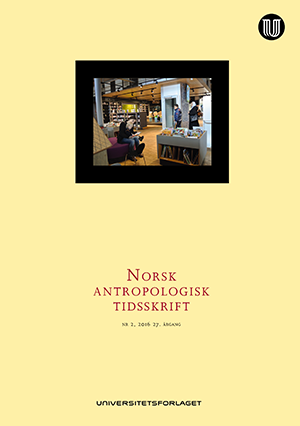
Braten, Eldar. 2016. “Critical realist anthropology--exemplification of a non-conflationary perspective.” Norsk antropologisk tidsskrift 27(2): 121-137.
The article illustrates the analytical utility of the perspective of critical realism as applied to a debate on the quality of public eldercare in Norway. Inspired by the philosopher Roy Bhaskar, I argue for an anthropology that acknowledges ontological complexity, particularly as regards the distinction between structure and agency in the formation of social practice. While dominant perspectives in anthropology tend to project unidimensional forms of analysis, often in a conscious attempt to debunk ‘Western dualisms’, I draw on Bhaskar to argue that such epistemological distinctions reflect aspects of reality. Thus framed – as non-reducible ontological levels – structure and agency need to be analysed in their own separate terms; hence, we should adopt a multifaceted, non-conflationary analytical approach. Applying this perspective, I attempt to mediate between the polar positions in the debate on eldercare and suggest an anthropology that seeks to go beyond empirical phenomena to uncover underlying formative mechanisms, that emphasises temporality in the formation of social praxis, that recognises the existence of ontological levels, and that dares to assess human knowledge about reality.
Med utgangspunkt i en disputt om betingelsene for kvalitet i offentlig norsk eldreomsorg eksemplifiserer jeg sider ved en kritisk realistisk tilnærming til sosialt liv. Inspirert av filosofen Roy Bhaskar argumenterer jeg for en antropologi som anerkjenner ontologisk kompleksitet. Artikkelen fokuserer særlig på skillet mellom strukturelle og handlingsdrevne nivåer i utformingen av sosialt liv. Mens toneangivende antropologiske perspektiver fremmer én-dimensjonale analyser, ofte i en kamp mot «vestlige dualismer», hevder jeg med Bhaskar at slike epistemologiske distinksjoner reflekterer sider ved virkelighetens karakter. Forstått slik – som ikke-reduserbare ontologiske nivåer – må struktur og agens analyseres ut fra sin egenart, ergo er det behov for en mangefasettert analytisk tilnærming. Artikkelen forsøker dermed å formidle mellom de standpunktene som kom til uttrykk i disputten og foreslår mer konkret en dybdeorientert antropologi som går bakenfor empiriske fenomener for å avdekke formative mekanismer, som vektlegger tidsdimensjonen i utforming av sosialt liv, som anerkjenner ontologiske nivåforskjeller og som tillater seg å evaluere menneskelig kunnskap om virkeligheten.

Kramer, Fritz W.. 2016. “Abschied von der Na chkriegsethnologie Der Fall der DGV -Tagung von 1969.” Paideuma 62: 223-241.
The history of anthropology in postwar Germany has been documented and interpreted, but in most cases with a narrow focus on the discipline. In this article, I try to widen this perspective with some reminiscences and reflections on the political atmosphere of the postwar era and the protest movement that brought it to its end, not only in anthropology. Under the collective amnesia of the Adenauer era, some of the most influential German anthropologists who had served the Nazi regime were still in office, having repressed their former ideological positions by covering them with a new, seemingly neutral terminology, and refraining from participating in international theoretical debates. This strategy of camouflage became a topic of discussion at the meeting of the Deutsche Gesellschaft fur Volkerkunde in 1969, when it came to a clash over the question of indigenous people facing genocide in Brazil. In Germany this turning point marked the beginning of a critique of anthropology and of a new ethnography based on Gadamer’s hermeneutics and on Wittgenstein’s ideal of ‘ubersichtliche Beschreibung’ (clear description).
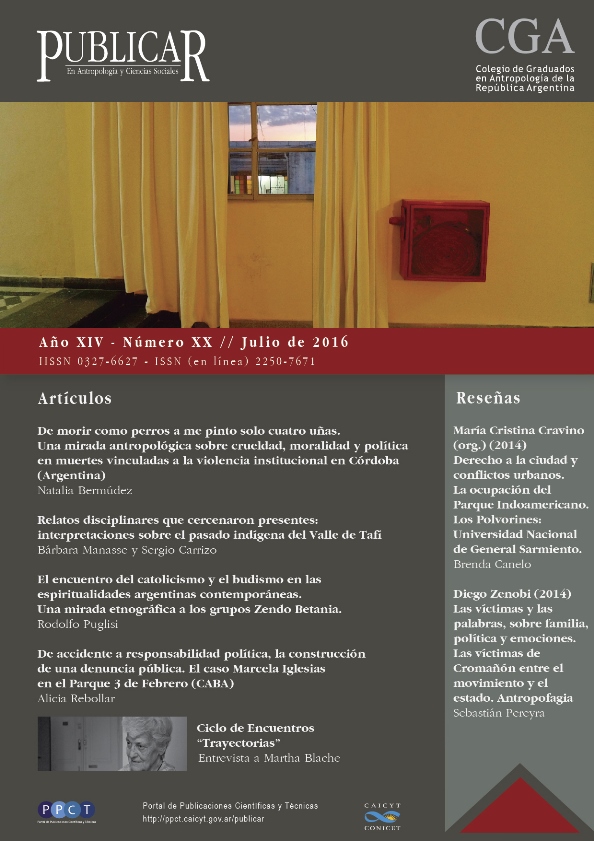
Bermúdez, Natalia. 2016. “De ‘morir como perros a me pinto solo cuatro uñas’. Una mirada antropológica sobre crueldad, moralidad y política en muertes vinculadas a la violencia institucional en córdoba (Argentina) From ‘to die like a dog’ to ‘I only paint myself four nails.’ An anthropological view of the cruelty, morality and politics of deaths in cases of institutional violence in Cordoba (Argentina).” Publicar en Antropología y Ciencias Sociales 11(20): 9-27.
In this article I intend to show how the acts of cruelty against young women and men coming from popular sectors, in cases of police and/or institutional violence, has aroused indignation among the relatives of the ‘victims’, who even counter the accusation of the dead moral issues. The reflections that I develop here are based on a much broader and comparative ethnographic research that I started in 2007, which focuses on the family, social and political networks associated to the deaths that occurred in slams and popular neighborhoods of the city of Cordoba in contexts of violence. These reflections are also based on an intervention work carried out by a group of universities and social organizations during a travelling photo exhibit. Although the expression ‘to die like a dog’ was tacitly shared by my interlocutors and was part of the repertories of denunciation, since it was used in the different ways of protest, I am interested in analyzing the specific criteria of animalization, insofar as they base the claim. According to my final suggestion, the codes of complaint that are used could end up legitimizing the use of violence as long as they place special emphasis on the modalities of cruelty rather than on the death itself.
En este artículo propongo mostrar cómo la crueldad ejercida sobre las y los jóvenes provenientes de sectores populares, en casos de violencia policial y/o institucional, ha despertado indignación entre los familiares de las ‘víctimas’, interpelando incluso cuestionamientos sobre las acusaciones morales que recaen sobre ellos. Las reflexiones que desarrollaré surgen de una investigación etnográfica y comparativa más amplia que llevo a cabo desde 2007, y que aborda redes de relaciones familiares, sociales y políticas vinculadas a muertes en contextos de violencia, en villas y barrios de sectores populares de la ciudad de Córdoba. Estas reflexiones también surgen de un trabajo de intervención entre la universidad y distintas organizaciones en torno a una muestra de imágenes itinerante. Si bien morir como un perro ha resultado una expresión tácitamente compartida por mis interlocutores como parte de los repertorios de denuncia que ponen a disposición en los espacios en los que se movilizan, me interesa problematizar aquellos criterios específicos de animalización a los que hacen referencia, en tanto fundan el reclamo. Según sugeriré, los repertorios de denuncia así expuestos podrían terminar por legitimar la violencia en la medida en que colocan su acento sobre las modalidades de la crueldad, y no sobre la muerte misma.
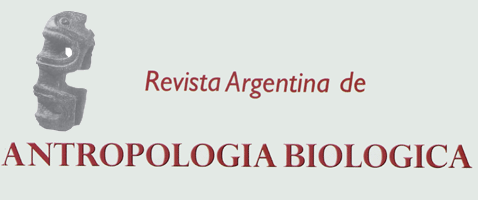
Assis, Sandra, Ana Luísa Santos and Anne Keenleyside. 2016. “Paleohistology and the study of human remains: past, present and future approaches.” Revista Argentina de Antropología Biológica 18(2): 1-17.
The invention of the microscope revolutionized the course of human knowledge. This instrument changed the face of science and of previous beliefs, expanded the horizons of knowledge, and challenged philosophical and scientific thought, especially in the field of natural sciences and medicine. In the domain of bioarchaeology, the introduction of histological techniques was important; not only to identify body tissues and to diagnose diseases in mummified remains, but also to understand bone and teeth microstructure, and associated patterns of response to environmental constraints. In this paper a critical review of the major contributions of histology to the growing body of knowledge in paleopathology and bioarchaeology will be presented, focusing on the current multiple applications of microscopy, its limitations, and its future challenges.
La invención del microscopio ha revolucionado el curso del conocimiento humano. Este instrumento cambió la “cara” de la ciencia y de las creencias anteriores, amplió los horizontes del conocimiento y retó al pensamiento filosófico y científico, especialmente en el campo de las ciencias naturales y la medicina. En el dominio de la bioarqueología, la introducción de técnicas histológicas fue determinante, no sólo para identificar los tejidos del cuerpo y diagnosticar enfermedades en restos momificados, sino también para comprender la microestructura y dinámica de los huesos y los dientes, y los patrones asociados de respuesta a las restricciones ambientales. En este trabajo se presenta una revision crítica de las principales contribuciones de la histología al creciente cuerpo de conocimientos de la paleopatología y la bioarqueología, con énfasis en las actuales aplicaciones de la microscopía, sus limitaciones y los desafíos para el futuro.
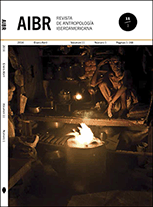
Assis, Sandra, Ana Luísa Santos and Anne Keenleyside. 2016. “Paleohistology and the study of human remains: past, present and future approaches.” Revista Argentina de Antropología Biológica 18(2): 1-17.
The work seeks to build theoretical and logical links based on the triadic theory of Charles Sanders Peirce (1839-1914) within the categories of cultural landscape and territory. The article tries to demonstrate how cultural landscapes and territory, as contrastable expressions in the empirical reality, constitute mental models that express complex rich and complicated social nuances and meanings in terms of scienti_c readings for anthropology. The work expresses how the spheres of semiotics signi_cance allow for a logical, metalogical and dialogical adjustment of the models of environmental interpretation, that exist in the field of environmental thought and in its readings of territory and culture.
El trabajo pretende establecer vinculos logico-teoricos de significacion con base en la Teoria Triadica de Charles Sanders Peirce (1839-1914) y las categorias de paisaje cultural y el territorio. Se intenta demostrar como los paisajes culturales y el territorio, como expression contrastable en la realidad empirica, se constituyen en modelos mentales que expresan matices y significados sociales ricos y complejos en posibilidades de lectura cientifica para la antropologia. El trabajo expresa la manera en que las esferas de significacion semiotica permiten establecer ajustes logicos, meta-logicos y dialogicos en los modelos de interpretacion existentes en el campo del pensamiento ambiental en sus lecturas del territorio y cultura.
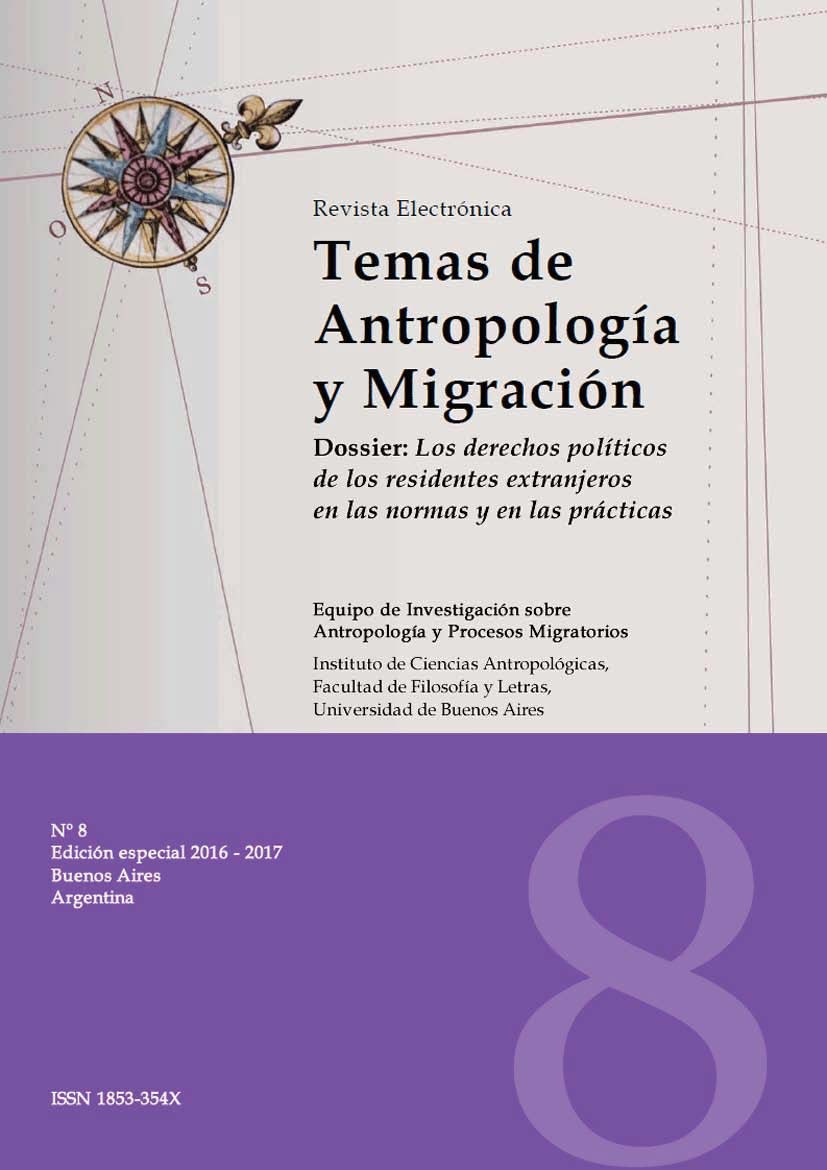
Canelo, Brenda. 2016. “Votar desde el exterior. Las experiencias boliviana y peruana en Argentina.” Revista Temas de Antropología y Migración 8: 132-155.
When leaving their country of origin, migrants often lose the capacity to vote its government, even if they identify themselves as part of that political community or send remittances of substantial economical impact. However, the several experiences of transnational voting that have taken place in the region in the last decade call for the comparative analysis and enquiry on the forms currently assumed by political belonging and citizenship practices, and pose questions on the territorial, social and symbolic limits of the modern nation State. In this paper I present and compare the establishment and exercise of transnational voting of Bolivian and Peruvian citizens residing in Argentina in the last two general elections of their countries of origin (2009 and 2014, and 2011 y 2016, respectively). I have reviewed bibliographical, hemerographic, documentary and statistical materials, and conducted interviews with key informants from Peru and Bolivia. I will describe and analyze: a) the social processes that allowed Peruvian and Bolivian citizens to vote from abroad; b) the main characteristics and results of these electoral days in Argentina; and c) the links promoted by the Peruvian and the Bolivian States with their citizens residing beyond national borders.
Al cruzar la frontera de su país de origen, los migrantes suelen perder la posibilidad de votar a las autoridades del mismo, aun cuando se identifiquen como parte de esa comunidad política o envíen remesas de impacto sustancial para su economía. No obstante, en los últimos años en la región se vienen produciendo distintas experiencias de voto transnacional, cuyo análisis comparativo contribuye a reflexionar acerca de las formas que asumen actualmente la pertenencia política y las prácticas ciudadanas, así como a repensar los límites territoriales, sociales y simbólicos del Estado nación moderno. En este trabajo presento y comparo el establecimiento y ejercicio de voto transnacional de ciudadanos bolivianos y peruanos residentes en Argentina en las dos últimas elecciones generales de sus países de origen (2009 y 2014, y 2011 y 2016, respectivamente). Para ello revisé materiales bibliográficos, hemerográficos, documentales y estadísticos, y efectué entrevistas a informantes clave de Perú y de Bolivia. A continuación describiré y analizaré: a) los procesos sociales que permitieron sufragar a ciudadanos peruanos y bolivianos desde el exterior; b) las principales características y resultados de esas jornadas electorales en Argentina; y c) los vínculos promovidos por el Estado peruano y por el Estado boliviano con sus ciudadanos residentes allende sus fronteras.
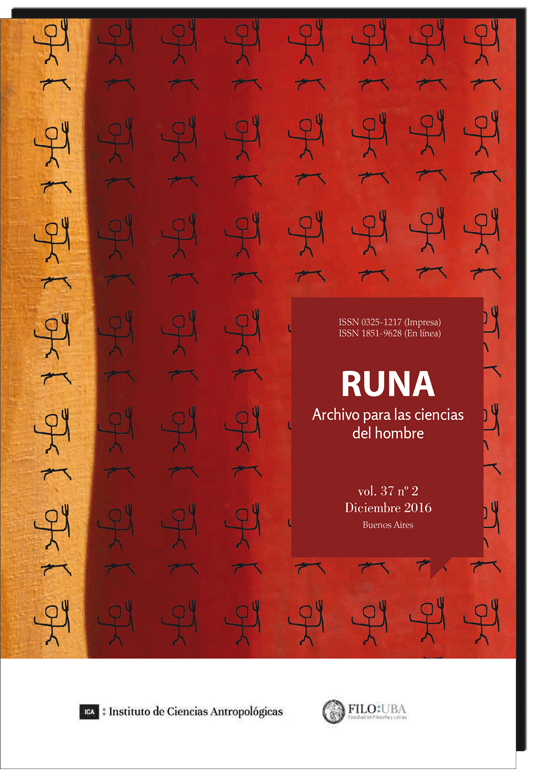
Ramos, Alejandra y Carlos María Chiappe. 2016.“Ana María Lorandi y el tren de la etnohistoria (Ana Maria Lorandi and the Ethnohistory's train ).” Runa 37(2): 97-113.
In 2016, Dr. Ana María Lorandi celebrated eighty years of life, more than fifty of which have been dedicated to investigative practice. At the time of writing, she is as active as ever, working on new projects and accompanying the new generations of anthropologists interested in Ethnohistory. For this article we have thought honoring her by examining her contributions through three forms of action that she developed prominently: participation in transnational networks, promotion of research and institutional management. Throughout the sections we propose to recover her voice, seeking to incorporate his vision on the history of a scientific development in which she has played a fundamental role.
En el año 2016 la Dra. Ana María Lorandi cumplió ochenta años de vida, más de cincuenta de los cuales han sido dedicados a la práctica investigativa. Al momento de escribir estas líneas se encuentra tan activa como siempre, trabajando en nuevos proyectos y acompañando a las nuevas generaciones de antropólogos interesados en la Etnohistoria. Para este artículo hemos pensado en homenajearla examinando sus aportes por medio de tres formas de acción que llevó delante de manera destacada: inserción en redes transnacionales, promoción de temas de investigación y gestión institucional. A lo largo de los apartados nos hemos propuesto recuperar su voz, intentando incorporar su visión sobre la historia de un desarrollo científico en el cual le ha cabido un papel fundamental.

Sissons, Jeffrey. 2016. “Dangerous Remains: Towards a History of Tapu.” Sites: A Journal of Social Anthropology and Cultural Studies 13(2): 49-65.
The historical and cultural focus of this article is a connected sequence of rites performed by and on behalf of Māori kin groups in the mid-19th century aimed at polluting sacred groves (wāhi tapu). I argue that these rites were a logical sequel to others aimed at removing the tapu (sacredness) from chiefs prior to mass conversion to Christianity in the early 1840s. Both sets of rites sought the separation of gods from kin-groups, a process that entailed a transformation of the nature of tapu.
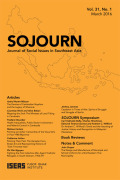
Work, Courtney and Alice Beban. 2016. “Mapping the Srok: The Mimeses of Land Titling in Cambodia.” SOJOURN Journal of Social Issues in Southeast Asia 31(1): 37-80.
In June 2012, Cambodia’s prime minister issued an order on land titling that deployed student volunteers to survey and map the country’s territory. Examination of this initiative at the theoretical intersections of mapping, mimicry and governmentality demonstrates the violent exclusions inherent in cadastral projects that restrict measuring and titling to only “productive” properties. In a field of speculation and local power the initiative dramatically refashioned the land to mimic in advance the expectations of the Map. The transformations altered land access and use in ways that told two stories about the power of the Map: “clear it or lose it” and “if you clear it, you can have it”. Neither story was fully realized, but the land was transformed nonetheless.
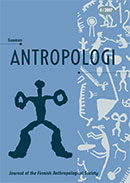
Keisalo, Marianna. 2016. “Picking People to Hate': Reversible reversals in stand-up comedy.” Suomen Antropologi: Journal of the Finnish Anthropological Society 41(4): 62-76.
Generally speaking, ritual reversals mean switching to the opposite of what is considered ‘the normal order’. Such reversals can occur, for example, in terms of social hierarchies in rites of passage, in action in carnival, or in the framing of action as ritual or performance. For comedic figures such as clowns and tricksters, reversals are part of their semiotic technique. By ‘reversible reversals’ I refer to the characteristic ambiguity of comedic performance and the ability of comedic figures to play with, combine, or shift between opposite traits, actions, and perspectives. In this sense, comedy can be said to constitute a series of reversals. Jokes can also be reversible in the way their outcomes are indeterminate: they may have a number of interpretations and effects but none are guaranteed. To illustrate this, I will demonstrate how reversals figure in organizing jokes and performance in a bit called ‘Picking People to Hate’ by stand-up comedian Louis C.K. Looking at comedic performance as reversible reversals is a way to show how humor can be efficacious and meaningful both in spite and because of its characteristic ambiguity. This will illuminate how stand-up comedy creatively engages its cultural grounds and show how the study of comedic performance can offer insights into the semiotics of performance more broadly.
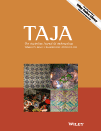
Smith, Michael French. 2016. “Bloody time revisited: New observations on time in a Papua New Guinea Village.” The Australian Journal of Anthropology 27(3): 370-385.
In a 1982 paper I argued that perceptions of time scarcity in Kragur Village, Papua New Guinea, in the mid-1970s were best understood as a reaction to new forms of authority characteristic of the growth of capitalism and calls for greater time order were grounded largely in its perceived ritual significance. More than forty years later, villagers are much more familiar with Western time, but less likely to perceive time as scarce. As in the 1970s, aspiring leaders still press for greater time order. Millenarian illusions informed advocacy of time order in the 1970s. Although today these illusions are, if not extinct, then dormant, unquestioned assumptions mirroring Western capitalist views of time inspire many of today’s advocates. Yet, lacking the authority to impose new forms of time order, they have little effect on the rhythms of village life, and economic incentives to abandon comparative indifference to time remain weak.

Sautchuk, Carlos Emanuel. 2016. “Eating (with) piranhas: untamed approaches to domestication.” Vibrant 13(2): 38-57.
In this article I begin by describing my sense of ethnographic unease concerning the commensality and the conviviality of two predators in Amazonian lakes – piranhas and fishermen. From this starting point I then discuss the notion of domestication, commenting on the current tendency to reaffirm use of the term in social anthropology and revisiting two approaches: that of Jean-Pierre Digard (and other French authors) and that of Tim Ingold, both of whom make use of this notion in their ethnographic explorations of the relation between humans and animals. The article then returns to explore the potential of the notion of domestication for making explicit contemporary questions and dilemmas such as nature and culture, human and animal, subject and object. I conclude with a reflection on the ideas of domestication and predation in the relationship between piranhas and fishermen.
Este artigo parte de uma inquietação etnográfica sobre a comensalidade e o convívio entre dois predadores nos lagos amazônicos – piranhas e pescadores. Deste ponto de partida será discutida a noção de domesticação, primeiro com um comentário sobre a tendência de reafirmação do termo na antropologia social e em seguida revisitando duas abordagens: a de Jean-Pierre Digard (e outros autores franceses) e a de Tim Ingold, ambos tendo feito uso desta noção como modo de tratamento dos variados sentidos e formas das relações entre humanos e animais. O artigo trata então da noção de domesticação enquanto forma de explicitar questões e dilemas contemporâneos como natureza e cultura, humano e animal, sujeito e objeto. Concluo com uma reflexão sobre as ideias de predação e domesticação para compreender a relação entre piranhas e pescadores.

Grieser, Anna. 2016. “When the power relationship is not in favour of the anthropologist: reflections on fieldwork in Gilgit-Baltistan.” Zeitschrift für Ethnologie 141(2): 177–196.
Without doubt, a great deal of fieldwork is monitored or influenced by government or intelligence services; yet, ethnography about such circumstances is rather exceptional. The reason for this, as I understand it, is the power that is attributed to the publication – and through it also to the ethnographer – possibly being harmful, due to the notion that publications can harm the researcher him- or herself, interlocutors or subsequent researchers. But is the researcher really as powerful as such a view proposes? Taking ethnography as a comprehensive project, i.e. comprising both ethnography and an ethnographic process, it should be clear that the ethnographer is often far from being in a position of power, regarding both ethnographic counterparts as well as powerful institutions and bureaucratic organisations. These elements affect not only the lives of the people anthropologists use to study, as Laura Nader (1972) proposed, but the fieldworker as well, by influencing his or her research possibilities and experiences and thus the ethnographic view and output. Examining my fieldwork under surveillance in Gilgit-Baltistan, the main concern of this contribution is to look at such power relations and how they influence the research. Setting the stage with an ethnographic encounter with intelligence officers, the article continues with a short discussion of the challenges of carrying out fieldwork under surveillance, followed by an overview of common surveillance practices in the region where the fieldwork took place. Subsequently, it offers a concise ethnography of fieldwork under surveillance, followed by an analysis of the premises on which the intelligence officers I encountered may have engaged as well as the local and cultural logic behind their engagement. I conclude with the proposition that the researcher is often far from being the one who decides about defining the terms of the research, ethnographic relationships or encounters.
